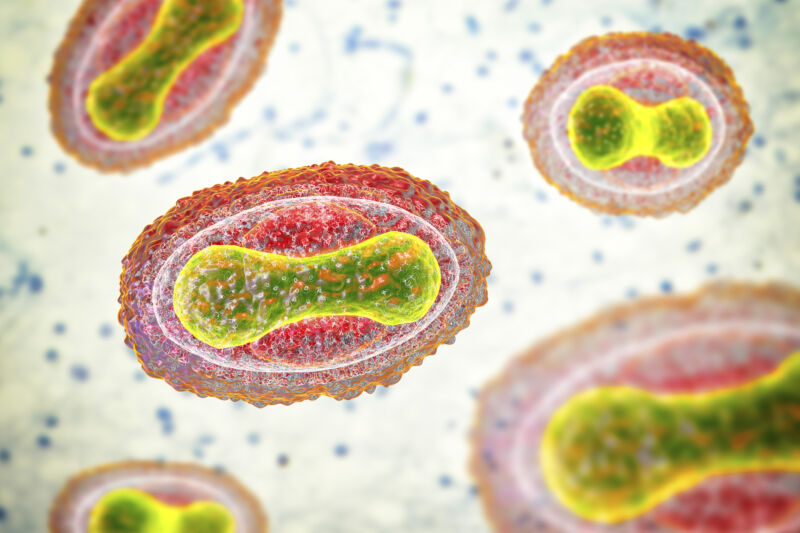
In November 2016, virologist David Evans traveled to Geneva for a meeting of a World Health Organization committee on smallpox research. The deadly virus had been declared eradicated 36 years earlier; the only known live samples of smallpox were in the custody of the United States and Russian governments.
Evans, though, had a striking announcement: Months before the meeting, he and a colleague had created a close relative of smallpox virus, effectively from scratch, at their laboratory in Canada. In a subsequent report, the WHO wrote that the team’s method “did not require exceptional biochemical knowledge or skills, significant funds, or significant time.”
Evans disagrees with that characterization: The process “takes a tremendous amount of technical skill,” he told Undark. But certain technologies did make the experiment easier. In particular, Evans and his colleague were able to simply order long stretches of the virus’s DNA in the mail, from GeneArt, a subsidiary of Thermo Fisher Scientific.
If DNA is the code of life, then outfits like GeneArt are printshops—they synthesize custom strands of DNA and ship them to scientists, who can use the DNA to make a yeast cell glow in the dark, or to create a plastic-eating bacterium, or to build a virus from scratch. Today there are dozens, perhaps hundreds, of companies selling genes, offering DNA at increasingly low prices. (If DNA resembles a long piece of text, rates today are often lower than 10 cents per letter; at this rate, the genetic material necessary to begin constructing an influenza virus would cost less than $1,500.) And new benchtop technologies—essentially, portable gene printers—promise to make synthetic DNA even more widely available.
But, since at least the 2000s, the field has been shadowed by fears that someone will use these services to cause harm—in particular, to manufacture a deadly virus and use it to commit an act of bioterrorism.
Meanwhile, the United States imposes few security regulations on synthetic DNA providers. It’s perfectly legal to make a batch of genes from Ebola or smallpox and ship it to a US address, no questions asked—although actually creating the virus from that genetic material may be illegal under laws governing the possession of certain pathogens.
Whether that’s a legitimate cause for alarm is under debate. Some experts say that creating a virus from synthetic DNA remains prohibitively difficult for most scientists, and that fears of an attack are often overblown. At the same time, new nonprofit initiatives, fueled by money from Silicon Valley philanthropists, and at times evoking worst-case scenarios, are pushing for more stringent protections against the misuse of synthetic DNA. Implementing effective security, though, is tough—as is enforcing any kind of norm in a sprawling, multinational industry.
“It’s not that I’m worried about something happening tomorrow. But the reality is, this capability is increasingly powerful in terms of how long the DNA fragments can be, what you can create with them, the ability of recipients to then assemble the DNA fragments into a new virus,” said Gregory Koblentz, a biodefense researcher at George Mason University. “This is the kind of thing that we really should be more proactive on—and try to get ahead of the curve.”
Perhaps the most prominent scientist sounding warnings about the danger of unchecked DNA synthesis is Kevin Esvelt, a biotechnologist at MIT. In conversation, Esvelt moves quickly between technical detail and Cassandra-like alarm. He often talks about Seiichi Endo, a Japanese virologist who, in 1987, joined the apocalyptic Aum Shinrikyo sect. Endo helped carry out a poison gas attack on the Tokyo subway, and the group tried—but seemingly failed—to obtain Ebola virus.
Since then, creating pathogens has gotten easier, thanks in part to the wider availability of synthetic DNA. “It’s really hard for me to imagine a graduate-trained virologist from Kyoto University being unable to assemble an influenza virus today,” Esvelt said.
As Esvelt describes it, the problem of synthetic biology is about power: New technologies have handed a group of scientists the keys to build unfathomably dangerous bugs. Very few—perhaps none—of those scientists has any wish to exercise this grim superpower. But, Esvelt argues, it’s only a matter of time before the next Endo comes along.
https://arstechnica.com/?p=1906453

